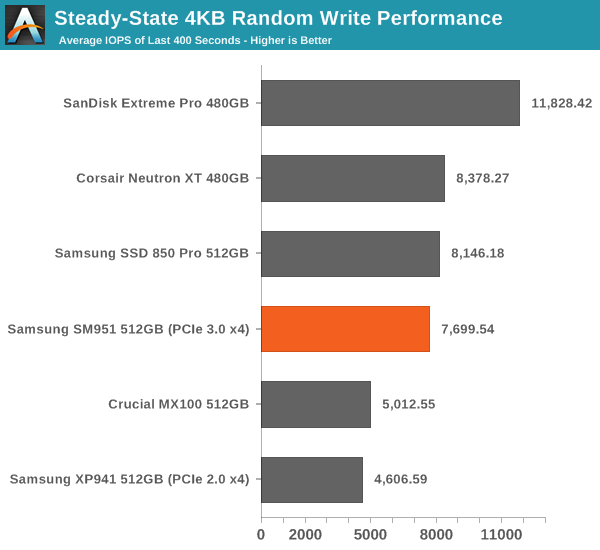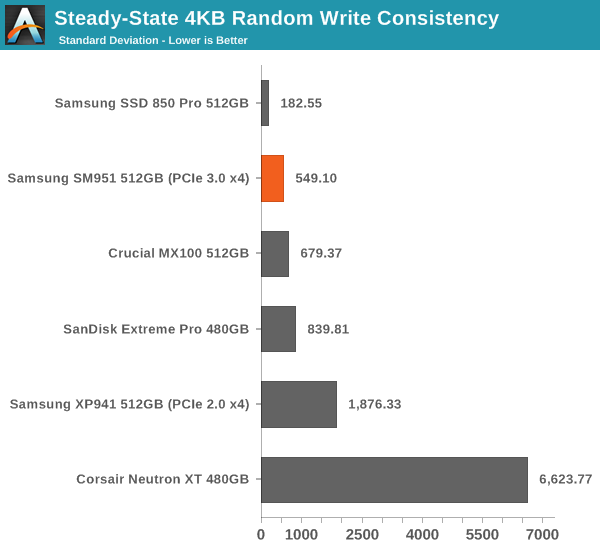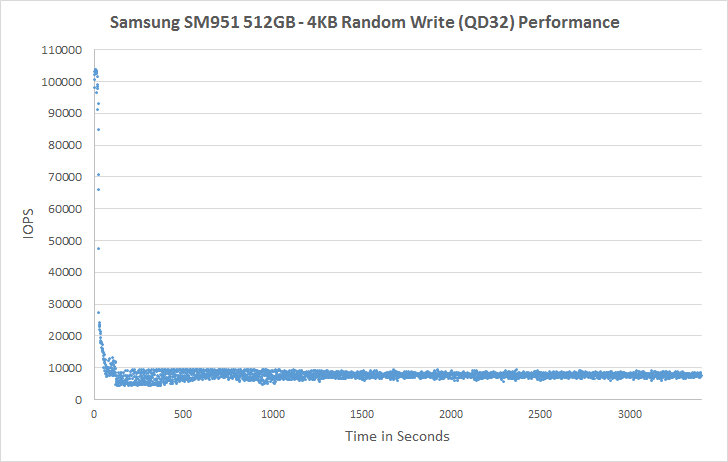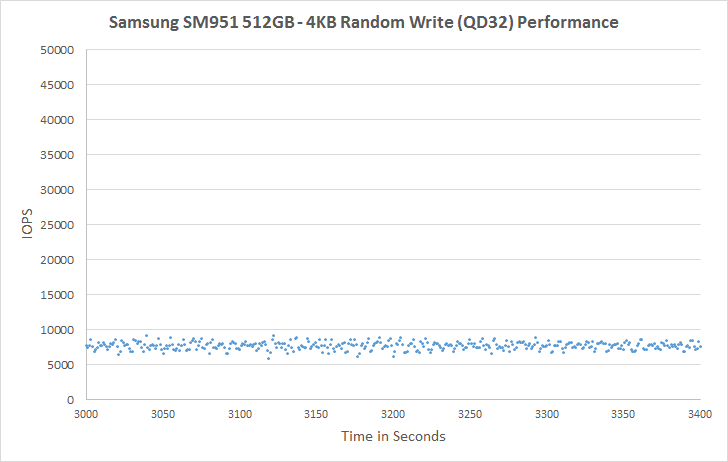Samsung SM951 (512GB) PCIe SSD Review
by Kristian Vättö on February 24, 2015 8:00 AM ESTPerformance Consistency
We've been looking at performance consistency since the Intel SSD DC S3700 review in late 2012 and it has become one of the cornerstones of our SSD reviews. Back in the days many SSD vendors were only focusing on high peak performance, which unfortunately came at the cost of sustained performance. In other words, the drives would push high IOPS in certain synthetic scenarios to provide nice marketing numbers, but as soon as you pushed the drive for more than a few minutes you could easily run into hiccups caused by poor performance consistency.
Once we started exploring IO consistency, nearly all SSD manufacturers made a move to improve consistency and for the 2015 suite, I haven't made any significant changes to the methodology we use to test IO consistency. The biggest change is the move from VDBench to Iometer 1.1.0 as the benchmarking software and I've also extended the test from 2000 seconds to a full hour to ensure that all drives hit steady-state during the test.
For better readability, I now provide bar graphs with the first one being an average IOPS of the last 400 seconds and the second graph displaying the standard deviation during the same period. Average IOPS provides a quick look into overall performance, but it can easily hide bad consistency, so looking at standard deviation is necessary for a complete look into consistency.
I'm still providing the same scatter graphs too, of course. However, I decided to dump the logarithmic graphs and go linear-only since logarithmic graphs aren't as accurate and can be hard to interpret for those who aren't familiar with them. I provide two graphs: one that includes the whole duration of the test and another that focuses on the last 400 seconds of the test to get a better scope into steady-state performance.

In steady-state performance the SM951 provides a substantial ~70% upgrade over the XP941 and brings performance nearly to the same level with the 850 Pro. Given that the 850 Pro uses faster V-NAND, the steady-state performance is a pleasant surprise and shows that the SM951 is more than a marginal bump from the XP941. Obviously, drives with more default over-provisioning (i.e. Extreme Pro and Neutron XT) provide higher steady-state performance, but Samsung is doing very well with the default 7% over-provisioning.

The consistency of the SM951 is also great. The Neutron XT is a living proof of a drive with high average IOPS, but horrible consistency because as we can see in the graph above its standard deviation is up to dozens of times higher compared to the other drives. That's just not acceptable for a modern drive, especially because there are many drives that can consistently provide high IOPS.
 |
|||||||||
| Default | |||||||||
| 25% Over-Provisioning | |||||||||
For a dozen seconds or so, the SM951 is actually able to burst out 100K IOPS, but the performance soon drops to below 10K IOPS and eventually evens out at ~7.5K IOPS. The SM951 is very consistent and doesn't experience any notable IOPS drops, whereas the XP941 regularly drops to a few hundred IOs per second. Increasing the over-provisioning to 25% brings the IOPS to about 35K, which is very decent and again much better than the XP941 that still has odd drops in performance.
 |
|||||||||
| Default | |||||||||
| 25% Over-Provisioning | |||||||||










128 Comments
View All Comments
Laststop311 - Tuesday, February 24, 2015 - link
Also forgot to add really need the 1TB size because 25% OP is important to keep the drive fast 100% of the time.theduckofdeath - Tuesday, February 24, 2015 - link
Are you using your PC as the google.com web portal? :)Isn't 25% a bit excessive for a PC? I have 10% now and I can't really notice any difference from my previous install when I had around 15%....
philipma1957 - Saturday, February 28, 2015 - link
I agree with you as always ssd's are too small. I would love to get a 2tb ssd or even a 1.5tb ssdin pcie or 2.5 inch form factors. My needs are about 1.2tb space. I would like the 1 drive and just forget about it.
RazrLeaf - Tuesday, February 24, 2015 - link
So when is someone going to make a PCIe SSD with a black PCB? It sounds trivial, but it's pretty easy to fix. A green SSD would stuck out like a sore thumb on a motherboard with a black PCB.vLsL2VnDmWjoTByaVLxb - Tuesday, February 24, 2015 - link
Probably when greater than 1% of the market even cares.sablesg - Tuesday, February 24, 2015 - link
Plextor has a black edition of their M6e drive. Although I believe that comes with a pcie slot to M.2 adapter, and I'm not sure if they plan to sell just the drive alone.eanazag - Tuesday, February 24, 2015 - link
This is a PC OEM drive with the likelihood of it ending up in a laptop/tablet, so PCB color is not of high importance unless it is Apple. Apple PCBs are usually black.Expect something more visually appealing in retail versions.
I'd be more interested in thermal pads or heat spreaders for this drive.
cm2187 - Tuesday, February 24, 2015 - link
Personally I will NOT buy this until the engraving on the chips are using the font Courrier.bigboxes - Wednesday, February 25, 2015 - link
Brav-freakin'-oMykeM - Tuesday, February 24, 2015 - link
You can get the original SSD part from Apple via iFixit. It's not cheap but it comes with black PCB (because Apple uses back PCB on MBP logic boards):https://www.ifixit.com/Store/Mac/MacBook-Pro-13-In...